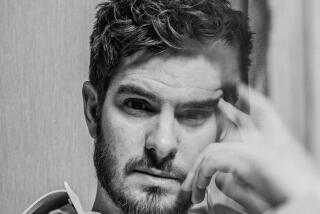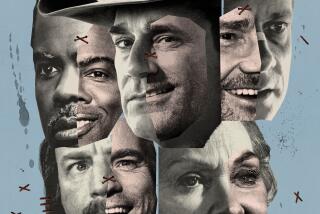‘What about Stan?’ Jay R. Ferguson’s ‘Mad Men’ breakout landed him his riskiest role yet
On a recent Thursday night in the San Fernando Valley, Jay R. Ferguson sat in a wood-paneled gastropub snacking on olives and potato chips. A pair of black-framed glasses rested on his face; in his left hand he clutched a red-and-white vape pen. His wardrobe choices — a “Star Wars” T-shirt and Dallas Cowboy sweatpants — broadcast two of his greatest loves.
And then there was his beard. Today’s forecast: contained, graying in patches, but flirting with the notion that it could once again blossom into magnificence. “It just never occurred to me it was a thing,” said the 45-year-old actor. “But it’s true. I can’t deny that there are a lot of people that have come up and commented on my beard.” It’s a powerful thing, man.
For years, Ferguson would grow out his facial hair between jobs. Back in 2010, when he booked a gig on the fourth season of “Mad Men,” they wanted him clean-shaven. He joined Matthew Weiner’s celebrated TV show as Stan Rizzo, a jocular art director who wore shirts too tight for his burly frame and saw the fermenting cultural liberation of the 1960s as a way to score chicks. But before filming began on Season 6, set largely in 1968, Ferguson was instructed to grow out his hair and beard.
When those episodes aired, Stan became more than a stealth fan favorite. He turned into a hirsute, hilarious and increasingly sensitive crush object to men and women alike. As the series went on, the beard got woollier; then, in the finale, it became part of the rom-com-iest moment of the show’s entire run as Stan and Elisabeth Moss’ Peggy Olson finally acknowledged their love for each other.
In the years since “Mad Men” smoked its last Lucky Strike, Ferguson’s charm has remained a near-constant presence on television. He was the patriarch for two seasons of “The Real O’Neals” and the lead in the short-lived sitcom “Living Biblically,” and appeared in multiple episodes of “The Mindy Project” and “Twin Peaks: The Return.” His installment of “The Romanoffs,” with Ferguson and Kathryn Hahn as an American couple on a disorienting journey to Russia to adopt a baby, was a standout in Weiner’s poorly reviewed anthology series for Amazon.
Now Ferguson is one of the stars of “Briarpatch,” a Southwestern noir from executive producer Sam Esmail (“Mr. Robot”) that premieres Thursday on USA. Taking inspiration from author Ross Thomas’ 1984 mystery novel, the show follows Allegra “Pick” Dill (played by Rosario Dawson), an investigator for a U.S. senator who returns to her Texas hometown after her sister, a police officer, is murdered. At the same time, she’s trying to track down an infamous international arms dealer. Ferguson plays Jake Spivey, Dill’s best friend from childhood, who has gone from being one of the city’s poorest residents to an ostentatious, mischievous millionaire with a pair of giraffes as pets and a mansion filled with portraits of himself. He also used to work for said arms dealer and might be a war criminal.
Ferguson plays Spivey with the volume dialed way up. With his big beard flowing, he wears a cowboy hat modeled after John Travolta’s in “Urban Cowboy” and performs a coked-out dance sequence set to a new wave synth track from the early ’80s. But underneath the charismatic bravado lies the potential desperation of a man whose morality seems long gone. In a series filled with idiosyncratic, memorable performances, his may be the finest.
“This was a lot out of my comfort zone. It’s certainly way bigger and broader and some could even say more ridiculous compared to anything I’ve ever done,” said Ferguson. “Actors always say you’re supposed to do what you’re afraid of, but I think that’s [crap]. I hate that saying. I don’t like doing what I’m afraid of. I like doing what I’m comfortable with. That’s usually been my way of navigating through the business. But then this came along and I just couldn’t deny that there was some part of me that said, ‘You’ve got to take this chance.’”
There are important differences between the book and the TV series. The white male protagonist is now a Latina, there are key plot threads about the Mexican border, and Spivey’s potentially incriminating acts happened in the Middle East, not Southeast Asia. But the fundamentals of Spivey’s devilish approach to life remain intact.
In Thomas’ novel, a character describes him as “sort of a walking miracle: You don’t quite believe it, but you sure as hell hope it’s true.” Andy Greenwald, the show’s creator and showrunner, said that Spivey was one of the characters that motivated him to adapt “Briarpatch” in the first place.
“I was really worried about this part, more than any of the others, mainly because the more I thought about it, the more I got concerned that they don’t make actors like this anymore,” Greenwald said. “I realized I needed someone who could be physical and funny and charismatic and sexy and menacing and all of the little things that make this character so memorable. All the actors I kept thinking about were people who were the right age in the ’70s. America just doesn’t produce people like this anymore. I was just beginning to freak out about it when, all credit due to my wife, she just sort of casually looked up from whatever she was reading and said, ‘What about Stan?’”
Though Ferguson accepted the unrestrained performance that the role demanded, it didn’t come naturally. “It was a daily exercise in fear and terror and self-loathing, just constant doubt,” Ferguson admitted. “The people there, Andy and all of the creative team, must have gotten so tired of me constantly checking and double-checking and triple-checking that [the performance] was OK.”
“Briarpatch” is the first show Greenwald created. Before becoming a TV writer, he worked as a critic, and as filming began in New Mexico, he found himself leaning on the veteran Ferguson in turn as he figured out how to make an actual television show. “He looked out for me,” Greenwald said. “He told me what it was like working with Matt Weiner. He told what it was like working with other showrunners. He laid a baseline for me of what I should expect in terms of the people who work for me and work with me. There were times on set when I wasn’t getting things exactly how I wanted to, he was the one who took it upon himself to make sure that I did.”
The show also lets Ferguson do a Texas accent, paying tribute to the state where he was born, where he spent his summer vacations growing up and where his football allegiances remain. Still, he deflects any notion that this part is a chance to show who he really is. “Look, I’m a proud Texan, but I’m not your typical Texan,” Ferguson said. “I’m more of a hippie.” (As if to offer proof, the day after our interview, he flew to Cancun for Dead & Company’s three-night Playing in the Sand event.)
Ferguson spent his earliest years in Dallas, where his mother, Bobbie, was an actress. When she divorced his father, she moved with her 7-year-old son to Los Angeles so she could develop her career there. They settled in Sherman Oaks, where Ferguson now lives with his wife and three sons.
Growing up, Ferguson traveled around the city with his mother as she went on auditions and soon took up acting himself. In 1990, he appeared as Ponyboy Curtis in Fox’s TV adaptation of “The Outsiders,” which was executive produced by Francis Ford Coppola. It lasted 13 episodes. He soon landed the role of Burt Reynolds’ and Marilu Henner’s son in the more successful “Evening Shade” and fell in with a group of teenage sitcom actors that included Leonardo DiCaprio, Tobey Maguire and Kevin Connolly — a pack that became both more famous and somewhat infamous when they came of age.
Ferguson continued to find work throughout his 20s and early 30s, but nothing quite caught on for him. “My good fortune was very sporadic, and it was always feast or famine,” he said.
In 2008 he found himself with less than $1,000 in the bank, a house that was a month away from foreclosure and his first child on the way. With his son just days old, he landed a role on “Easy Money,” a quirky family drama that the CW sent straight to series, bypassing the lengthy and uncertain pilot process. It may now seem like a footnote — only eight episodes made it on the air — but without the “Easy Money” break, Ferguson doesn’t know if he would have been around to get “Mad Men,” the job that changed the trajectory of his life. ”I had one foot out the door,” he remembers. “if I was going to try and course correct and find something else to do, that was the time and I needed to get … on with it before it was really too late.”
Along with “Briarpatch,” Ferguson plays a recurring character on “The Conners,” ABC’s Roseanne Barr-less version of “Roseanne.” He joined the cast as a new point in a romantic triangle involving the perennially sarcastic Darlene Conner (played by Sara Gilbert) and David Healy (Johnny Galecki), whose on-screen history stretches over two decades and two on-screen children. Gilbert is now an executive producer on “The Conners” and has known Ferguson since those early-’90s sitcom days. You can even find a picture online of the two of them attending the MTV Video Music Awards in 1992. Ferguson’s peace sign belt buckle is fantastic.
“Part of my concern was the audience would always root for David because it’s such a long-standing relationship,” Gilbert said of her decision to bring in Ferguson. “I felt like because Jay and I had been friends for 30 years, even if people aren’t conscious of that, that somehow subconsciously that depth of that relationship might resonate in a different way than if I cast somebody that I had no relationship with.”
If there is some specific reason why Ferguson is having a career resurgence now — whether age or experience has unlocked something within him — Gilbert doesn’t think so. “He has always been one of the most gifted actors I know,” she said. “There’s no real reason that there would have been any space in between [him getting recognition], except that’s just what happens to people.”
Ferguson does feel like he has a new confidence that sometimes evaded him. As to whether the beard has something to do with his recent success, Ferguson remembered a play he performed in long ago. It was a miserable experience — every night he was a bundle of nerves. But in this show each actor had a primary character, as well as a secondary character that they performed while wearing a mask. Doing the part in the mask was Ferguson’s favorite point every night. “Then I was brave, I felt like I could do anything,” he said. “I can see how [a beard] can kind of do the same thing to a certain degree. It’s not as great as a mask, but it’s halfway there.”
More to Read
The complete guide to home viewing
Get Screen Gab for everything about the TV shows and streaming movies everyone’s talking about.
You may occasionally receive promotional content from the Los Angeles Times.






